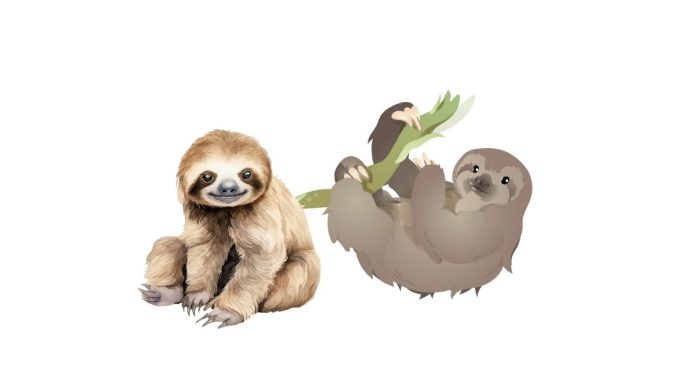Sloths are fascinating, slow-moving mammals that primarily reside in the rainforests of Central and South America. Their diet and drinking habits are quite unique, as they have adapted to their environment in a way that suits their leisurely lifestyle. Below is a detailed breakdown of what sloths eat and drink:
Diet of Sloths
Sloths are herbivores, meaning they primarily consume plant material. However, their diet is rather specialized, and their food choices are influenced by their slow metabolism and the environments they inhabit.
1. Leaves
- Primary Food Source: The majority of a sloth’s diet consists of leaves. Sloths are known to feed on the leaves of a variety of trees, particularly those found in their tropical rainforest habitats.
- Preferred Leaves: They primarily eat leaves from trees like cecropia, mimosa, and fig. These trees are abundant in the rainforests and offer a steady supply of food.
- Slow Digestion: Sloths have a slow metabolism (which is partly why they are so sluggish), and it takes them a long time to digest the leaves they consume. Some sloths can take several days to fully digest a meal.
- Low Nutritional Value: The leaves they eat are typically low in nutrients (especially protein and carbohydrates). As a result, sloths need to consume large quantities of leaves to meet their nutritional needs, but because leaves are difficult to digest, sloths do not need to eat as often as more active mammals.
2. Flowers
- Supplementary Food: In addition to leaves, sloths will sometimes consume flowers, though this is not their primary food source.
- Occasional Consumption: Flowers may provide a bit of extra nutrition, including some sugars and nectar. The sloths may feed on flowers if they are available, but this is less common than leaf consumption.
3. Fruits
- Rare Fruit Consumption: Sloths occasionally eat fruits, but this is a less frequent part of their diet. They may consume fruits that fall from trees, such as berries or tropical fruits like mangoes and bananas, but these are usually not staples in their diet.
- Nutritional Benefits: Fruits, when consumed, provide sloths with some extra vitamins and sugars that help supplement their relatively low-energy diet from leaves.
4. Insects and Small Vertebrates (Rarely)
- Occasional Insects: Some species of sloths, particularly the Pygmy three-toed sloth, may eat small insects such as ants, termites, or snails. However, this is not a significant part of their diet and is considered more of a supplement when other food sources are scarce.
- Rare Animal Consumption: Sloths are not known to be carnivorous, and eating insects or small animals is an occasional behavior rather than a common part of their diet.
Drinking Habits of Sloths
Sloths have adapted to a diet that is mostly made up of leaves, which contain moisture, so they don’t need to drink water as often as other mammals. However, they do occasionally drink water, particularly if the moisture content of their food is insufficient.
1. Drinking Water from Rain or Puddles
- Drinking Method: Sloths rarely drink from streams or rivers, as they are not particularly agile on the ground. Instead, they may drink from rainwater that collects on leaves, tree branches, or other surfaces. They also drink from puddles or other small water sources that collect on the forest floor or within their habitat.
- Slow Drinking: Due to their slow movements, sloths will take their time drinking water from these sources. They will use their mouths to lap up the water in small amounts.
- Low Water Intake: Sloths are adapted to survive on relatively low water intake because they primarily get their hydration from the moisture found in the leaves they consume. This is one of the reasons their diet is so specialized – the moisture in the leaves helps maintain their hydration levels.
2. Moisture from Leaves
- Hydration from Food: The leaves that sloths eat are often very moist, providing them with the bulk of their water needs. The high moisture content in these leaves compensates for the sloth’s limited drinking habits. They often do not need to drink water regularly, as their food offers sufficient hydration.
- Low Energy Needs: Since sloths move slowly and have a low metabolism, they do not require a large amount of water compared to more active animals. This allows them to thrive on a diet that doesn’t always need to include drinking large amounts of water.
Digestive System and Energy Needs
- Slow Digestion: Sloths have a complex digestive system. Their stomach is multi-chambered, similar to that of a cow, which helps them break down tough plant material like leaves. Their intestines are also long, allowing them to absorb as many nutrients as possible from their food.
- Low Energy Requirements: The low energy content of their diet means sloths don’t need to eat constantly. In fact, they can go for several days without eating and can survive on relatively small amounts of food, which is one of the reasons they have such slow movement and sleep patterns.
Conclusion
In summary, sloths primarily eat leaves, which provide most of their nutritional needs, supplemented occasionally by flowers and fruits. Their low-energy diet means they don’t require much water, and they often get sufficient hydration from the moisture in the leaves they consume. When they do drink, it’s typically from rainwater or puddles. The sloth’s unique diet and drinking habits, combined with their slow metabolism, make them well-adapted to their rainforest environment, where food is abundant but often low in energy.


